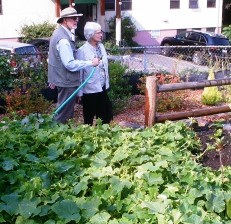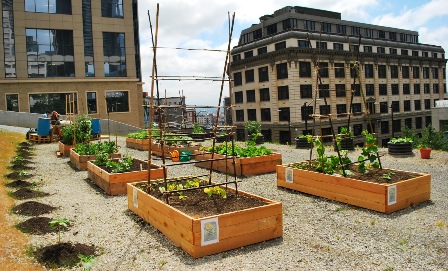Growing and Giving
This video was developed by a VISTA member and is intended to accompany the information on the online produce recovery guide.
Each year, Giving Gardeners grow and donate over 20,000 pounds of fresh, organic produce to local shelters, meal programs, and food banks.
Where/how to grow
There are three main approaches to Growing & Giving, and many gardens utilize all three:
-
 In the case of P-Patches, most gardens have at least one dedicated food bank plot called a Giving Garden. One or more Giving Garden coordinators oversee planting, harvesting, and delivery, while other volunteers help with each of these tasks. All P-Patch gardeners have to complete at least 8 hours of volunteering in their P-Patch, and many choose to help in the Giving Garden. In addition, individuals and other organizations have created Giving Gardens on their property from backyards to parking strips.
In the case of P-Patches, most gardens have at least one dedicated food bank plot called a Giving Garden. One or more Giving Garden coordinators oversee planting, harvesting, and delivery, while other volunteers help with each of these tasks. All P-Patch gardeners have to complete at least 8 hours of volunteering in their P-Patch, and many choose to help in the Giving Garden. In addition, individuals and other organizations have created Giving Gardens on their property from backyards to parking strips.
-
Giving Garden coordinators also encourage other gardeners to Grow a Row in their own plots. They are responsible for planting and harvesting, and there is often a designated area to leave donations, so that they can be delivered along with the harvest from the Giving Garden.
-
Gleaning can generate a huge amount of produce to donate, while preventing waste and keeping gardens productive. Some gardens use a system of flags or stakes to indicate which plots/rows/crops can be harvested for donation. Giving Garden coordinators also ask for permission to lightly glean individual plots when gardeners are away on vacation, another good way to collect produce on donation days.
What to grow
First, think about preferences of food bank clients.
-
Learn about the clientele of the food bank you’ll be donating to, and do your best to provide culturally appropriate produce.
-
Choose familiar varieties. Unfamiliar or uncommon vegetables might need some explanation that food bank staff and volunteers may not have the time or expertise to provide.
-
Only donate clean, unblemished fruits and veggies.
-
If you wouldn’t buy it for yourself, don’t donate it. Herbs are often a big hit!
Each food bank is different. Check in with staff before you begin planting and donating, and keep in mind:
-
Whatever you donate will have to withstand a certain degree of handling before it goes home with anyone.
-
Don’t donate produce that is overripe or easily bruised.
-
Ask about how to package donations. Don’t waste your time bagging veggies if they’ll only be dumped and repackaged. Food banks that are very busy may not be able to accept smaller donations. If you only have a small amount of each type of produce, check with local shelters and meal programs.
-
Places that prepare meals on-site may be able to make better use of smaller amounts of produce. Most food banks already receive lots of potatoes and storing onions through the commodity system, and would prefer to receive other fresh veggies.
Since the gardeners maintaining the food bank plot are often volunteers, try to keep things low-maintenance:
-
Herbs and vegetables, such as greens, can be harvested over and over, saving you the work of planting and re-planting.
-
Some will even reseed themselves at the end of the season!
-
Growing just one or two crops means less work for gardeners and larger harvests for food banks.
When to harvest
 Ideally, you would harvest and deliver produce the same day that the food bank will distribute it—many food banks would prefer to take donations before distribution begins so they have time to process everything. If that isn’t an option, it is necessary to find a way to store and keep produce fresh. Many P-Patches have a designated area in a shed where gardeners can drop off produce they would like to donate. This area often includes a scale and logbook, extra bags and boxes, and a cooler for storing highly perishable vegetables. Another great way to keep vegetables fresh is to keep them in buckets of cold water until they are ready to be delivered. Make sure to wash the produce well and keep it separated by type. Finally, don’t forget to label everything! Lettuce Link has a set of multilingual labels that gardeners can use (scroll to the bottom of the page).
Ideally, you would harvest and deliver produce the same day that the food bank will distribute it—many food banks would prefer to take donations before distribution begins so they have time to process everything. If that isn’t an option, it is necessary to find a way to store and keep produce fresh. Many P-Patches have a designated area in a shed where gardeners can drop off produce they would like to donate. This area often includes a scale and logbook, extra bags and boxes, and a cooler for storing highly perishable vegetables. Another great way to keep vegetables fresh is to keep them in buckets of cold water until they are ready to be delivered. Make sure to wash the produce well and keep it separated by type. Finally, don’t forget to label everything! Lettuce Link has a set of multilingual labels that gardeners can use (scroll to the bottom of the page).
Where to donate
Ideally, you will be donating on a regular basis (whether it’s weekly, biweekly, or monthly) throughout the growing season. When you’re looking for a place to donate, choose somewhere that you can build a relationship with. Make sure that they are a good fit in terms what you’re able and willing to grow matching what they need, and that you’ll be able to come up with a delivery schedule that works for everyone.
How to get others involved
The more you integrate the idea of Growing & Giving into the culture of your garden, the more successful you’ll be in getting others involved! Here are some ideas:
-
Give new gardeners a Plant a Row sign and a packet of seeds along with their plot assignment.
-
Involve the food bank plot in every garden-wide work party.
-
Keep a running tally of how many pounds you’ve donated and let people know! Some gardens use a thermometer-style poster to display poundage, others challenge individual gardeners to make it into the “100+ club.”
-
Find a job for everyone—what can you delegate? Maybe not everyone can help with major work parties, but they may be able to deliver produce, water on off-days, grow starts, maintain tools, etc.
-
Look beyond the garden. Many of the most successful P-Patch Giving Gardens have dedicated volunteers who aren’t even plot holders. Reach out to the community or find a way to work with local schools or community organizations.
-
Tending to the Giving Garden can be a great way to learn about gardening. If you pitch it that way, you’ll have lots of eager volunteers who want to learn more!
Looking for more resources? Visit the Lettuce Link website and download Giving Garden Tips.

 In the case of P-Patches, most gardens have at least one dedicated food bank plot called a Giving Garden. One or more Giving Garden coordinators oversee planting, harvesting, and delivery, while other volunteers help with each of these tasks. All P-Patch gardeners have to complete at least 8 hours of volunteering in their P-Patch, and many choose to help in the Giving Garden. In addition, individuals and other organizations have created Giving Gardens on their property from backyards to parking strips.
In the case of P-Patches, most gardens have at least one dedicated food bank plot called a Giving Garden. One or more Giving Garden coordinators oversee planting, harvesting, and delivery, while other volunteers help with each of these tasks. All P-Patch gardeners have to complete at least 8 hours of volunteering in their P-Patch, and many choose to help in the Giving Garden. In addition, individuals and other organizations have created Giving Gardens on their property from backyards to parking strips. Ideally, you would harvest and deliver produce the same day that the food bank will distribute it—many food banks would prefer to take donations before distribution begins so they have time to process everything. If that isn’t an option, it is necessary to find a way to store and keep produce fresh. Many P-Patches have a designated area in a shed where gardeners can drop off produce they would like to donate. This area often includes a scale and logbook, extra bags and boxes, and a cooler for storing highly perishable vegetables. Another great way to keep vegetables fresh is to keep them in buckets of cold water until they are ready to be delivered. Make sure to wash the produce well and keep it separated by type. Finally, don’t forget to label everything! Lettuce Link has a set of
Ideally, you would harvest and deliver produce the same day that the food bank will distribute it—many food banks would prefer to take donations before distribution begins so they have time to process everything. If that isn’t an option, it is necessary to find a way to store and keep produce fresh. Many P-Patches have a designated area in a shed where gardeners can drop off produce they would like to donate. This area often includes a scale and logbook, extra bags and boxes, and a cooler for storing highly perishable vegetables. Another great way to keep vegetables fresh is to keep them in buckets of cold water until they are ready to be delivered. Make sure to wash the produce well and keep it separated by type. Finally, don’t forget to label everything! Lettuce Link has a set of